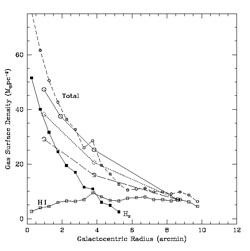


In this section we will briefly describe the properties of other spirals of the Local Group for which we have enough chemical information.
In external spirals we can measure:
 emission and this suggests a correlation between the SFR and the total
surface gas density, as discussed previously.
emission and this suggests a correlation between the SFR and the total
surface gas density, as discussed previously.
 , expressed as a
, expressed as a
 /
/
 MW, where
MW, where
 MW refers
to the Milky Way.
In fact, in the framework of semi-analytical models of galaxy formation the
evolution of galactic disks can be described by means of scaling laws
calibrated on the Milky Way with Vc and
MW refers
to the Milky Way.
In fact, in the framework of semi-analytical models of galaxy formation the
evolution of galactic disks can be described by means of scaling laws
calibrated on the Milky Way with Vc and
 as parameters (e.g.
Mo et al. 1998).
as parameters (e.g.
Mo et al. 1998).
 |
Figure 61. Distribution of the (B-H) color,
the 12+log(O/H), the gas fraction and the SFR efficiency (the SFR per
unit mass of gas) versus the circular velocity of disks of local
spirals.The different lines refer to different values of the spin
parameter |
8.1. Chemical models for external spirals
Several models of chemical evolution of Local Group spirals have been developed in the past years (e.g. Diaz & Tosi, 1984; Mollá et al. 1996; Chiappini et al. 2003). Diaz & Tosi (1984) first modeled the chemical evolution of M31, M33, M83 and M101. Mollá et al. (1996) modeled several spirals of the Local Group (M31, NGC300, M33, NGC628, NGC3198, NGC6946). In Figure 62 we show the predictions, compared to observations, of the Mollá et al. model for M31.
 |
 |
Figure 62. Predicted and observed abundance gradients in M31. Figure and models are from Mollá et al. (1996). |
As an another example of abundance gradients and gas distribution in a
local spiral galaxy we show in Figure 63
the observed and predicted gas distribution and abundance gradients for
the disk of M101. In this case the gas distribution and the abundance
gradients are reproduced with systematically smaller timescales for the
disk formation relative to the
MW (M101 formed faster), and the difference between the
timescales of formation of the internal and external regions is smaller
( M101 = 0.75
r(Kpc) - 0.5 Gyr,
Chiappini et
al. 2003)
compared to eq. (34).
M101 = 0.75
r(Kpc) - 0.5 Gyr,
Chiappini et
al. 2003)
compared to eq. (34).
 |
 |
Figure 63. Upper panel: predicted and
observed gas distribution along the disk of M101. The observed HI,
H2 and total gas are indicated in the Figure.
The large open circles indicate the models: in particular, the open
circles connected by a continuous line refer to a model with central
surface mass density of 1000
M |
Therefore, in the Chiappini et al. (2003) paper it is suggested that the fact that more luminous spirals ( e.g. M101) tend to have shallower abundance gradients than less luminous ones can be interpreted as due to a faster formation (down-sizing) of large spirals, as also hinted at by the results of Boissier et al. (2001).
In summary, from the available studies of spirals in the Local Group we can suggest the following: